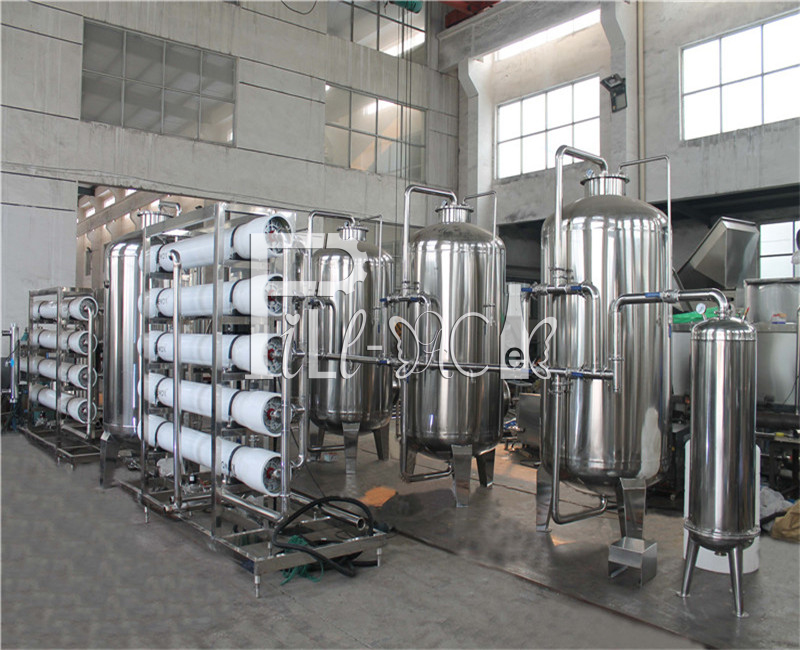- Tel.: +86 512 5864 3048
- E-mail: admin@fillpackmachine.com
1 Overview
During the operation of RO equipment, the surface of the reverse osmosis membrane will be deposited due to the presence of pollutants such as mud, jelly, organic matter, microorganisms, etc. in the raw water and the concentration of insoluble materials during the membrane separation process. , And then form pollution to the reverse osmosis membrane. We all know that the pretreatment device of the reverse osmosis system is specially designed to remove as much as possible the substances that cause membrane fouling. However, even if the system has a fairly complete pretreatment equipment, it cannot completely avoid the membrane in use Pollution, so it is necessary to periodically remove pollutants in the membrane system during the operation of the equipment. This operation process is called CIP (Cleaning In Place) of the reverse osmosis system.
After the reverse osmosis membrane is contaminated, there will be a decline in membrane performance such as reduced system water production and increased salt permeability. However, due to changes in other major factors (pressure, temperature, etc.) that affect the performance of the membrane during the use of reverse osmosis equipment, the phenomenon of membrane contamination may be covered by other factors, so attention should be paid.
At present, most aromatic polyamide reverse osmosis composite membranes on the market have considerable stability and certain temperature resistance in a wide pH range, so users can perform very effective cleaning of the reverse osmosis system. Years of engineering practice shows that it is very difficult to remove contaminants that have adhered to the membrane surface for a long time without cleaning the reverse osmosis system that has produced a certain degree of pollution in a timely manner.
In general, when considering the cleaning scheme of the membrane system, the following points should be noted:
■ The environmental impact (EDTA, fungicide, etc.) of cleaning waste liquid should be minimized.
■ Maximize the removal of contaminants in this cleaning process as much as possible.
■ The damage to the membrane should be minimized during cleaning (the first consideration should be the selection of agents that have a small effect on membrane performance).
■ In the actual cleaning operation, on the premise of ensuring the cleaning effect, the cleaning cost is minimized as much as possible

Ro Water Purification System
2. The cause of pollution in RO water purification system
■ Inappropriate pretreatment
8226; The system is equipped with a pretreatment device that is not suitable for the quality and flow of raw water, or does not have the necessary process equipment and process links in the system.
8226; The pretreatment device does not operate normally, that is, the original pretreatment equipment of the system has a low ability to remove the raw water SDI components, turbidity, and jelly, and the pretreatment effect is not ideal.
■ The system selects inappropriate equipment or equipment material selection is incorrect (pumps, piping and others).
■ System chemical injection device failure (acid, flocculation/coagulant, scale inhibitor/dispersant, reducing agent and others).
■ Appropriate protective measures have not been taken after intermittent operation of the equipment or system stoppage.
■ Unreasonable operation and use of equipment by operation management personnel (recovery rate, water production, concentrated water volume, pressure difference, cleaning and others).
■ Long time accumulation of insoluble precipitate in the membrane system.
■ The composition of the raw water changes greatly or the characteristics of the water source have fundamentally changed.
■ A considerable degree of microbial contamination has occurred in the reverse osmosis membrane system.
3. Analysis of membrane pollutants
■ First of all, you should carefully analyze the recent equipment operation record data recorded before that can reflect the equipment operation status.
■ Analysis of raw water quality.
■ Confirm the cleaning results that have been done before.
■ Foreign substances left on the filter membrane during the measurement of the SDI value during the analysis system operation.
■ Analyze the accumulation on the filter element of the security filter of the reverse osmosis system.
■ Check for foreign substances in the piping of the raw water flowing into the system and the water inlet of the reverse osmosis membrane.
Copyright © ZhangJiaGang City FILL-PACK Machinery CO., LTD. All Rights Reserved
Technical Support: 